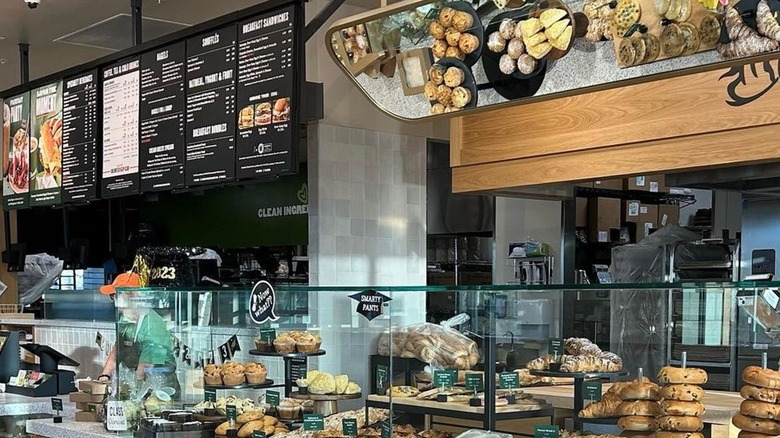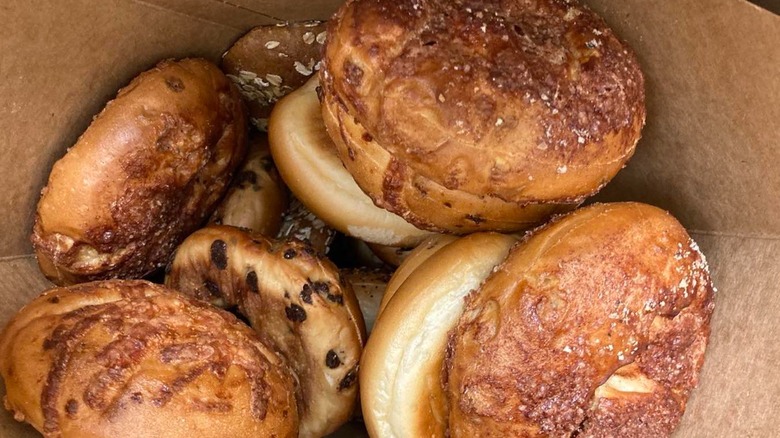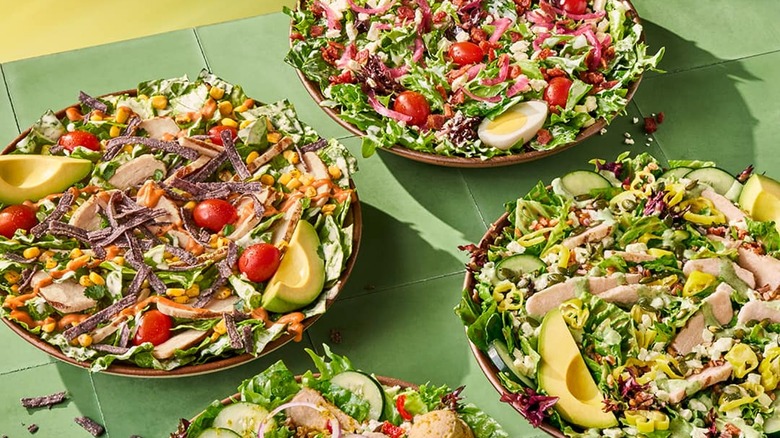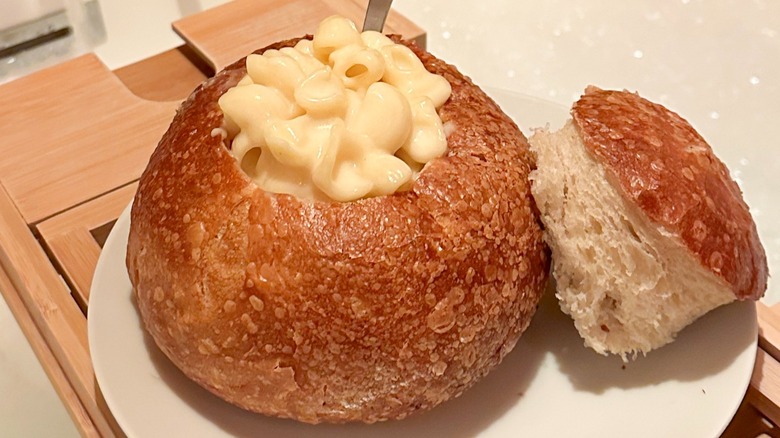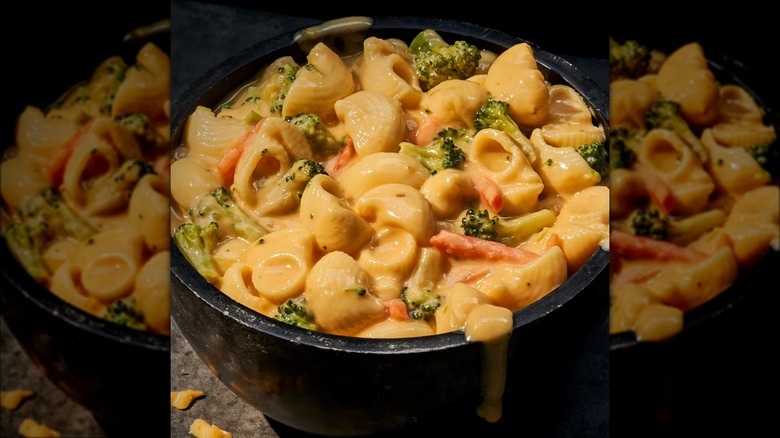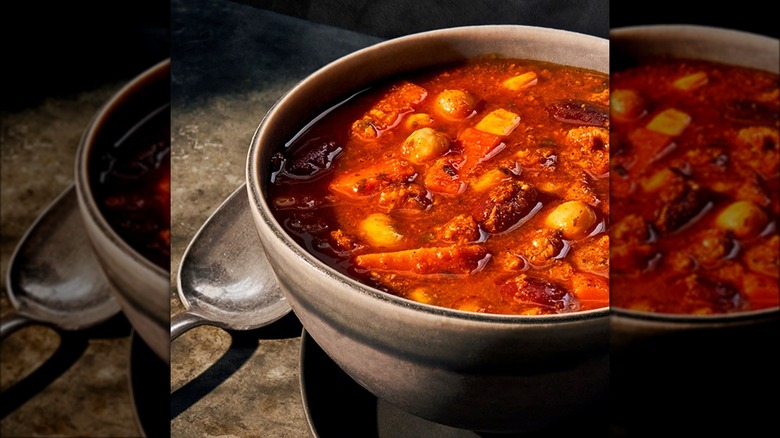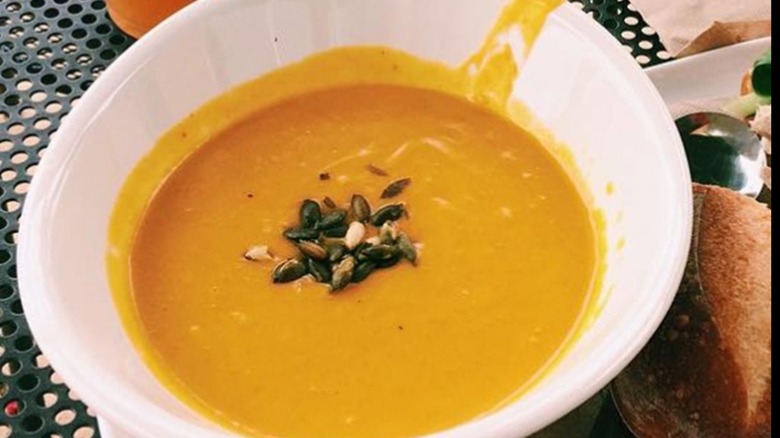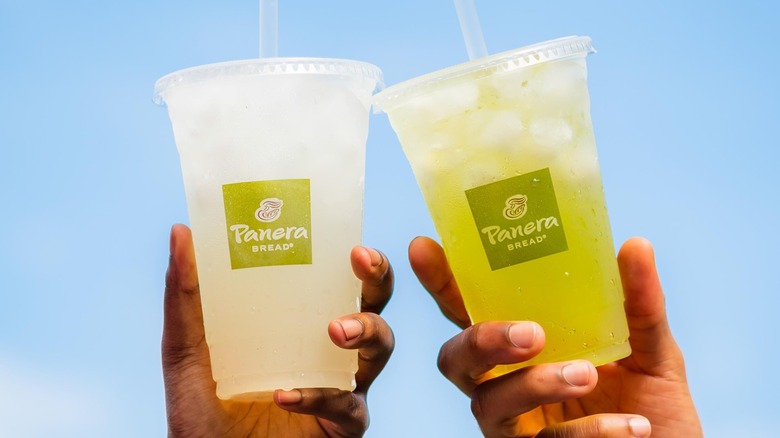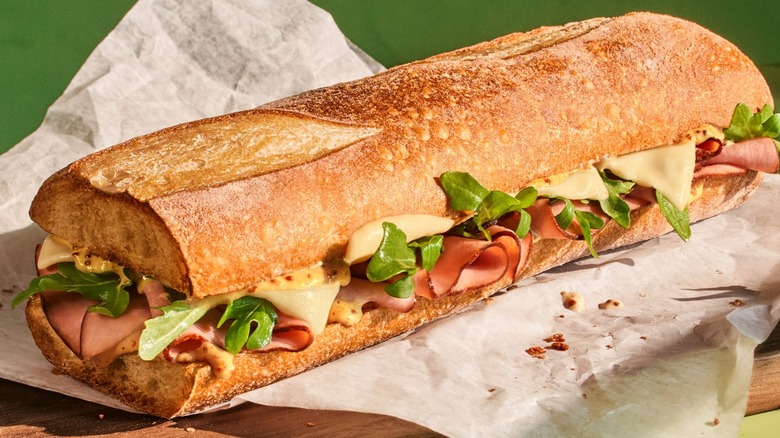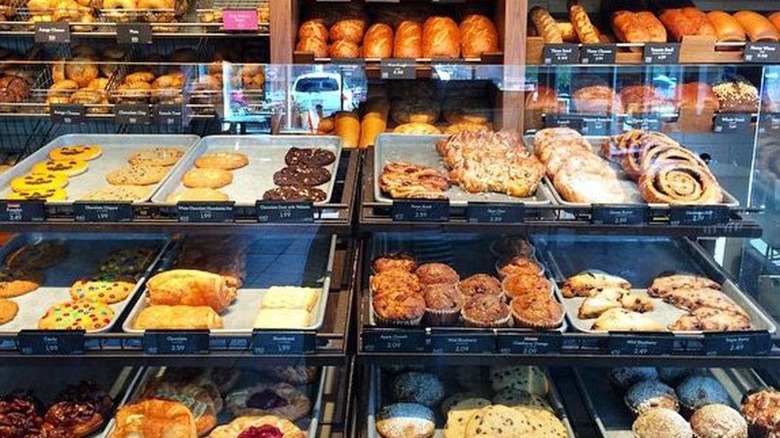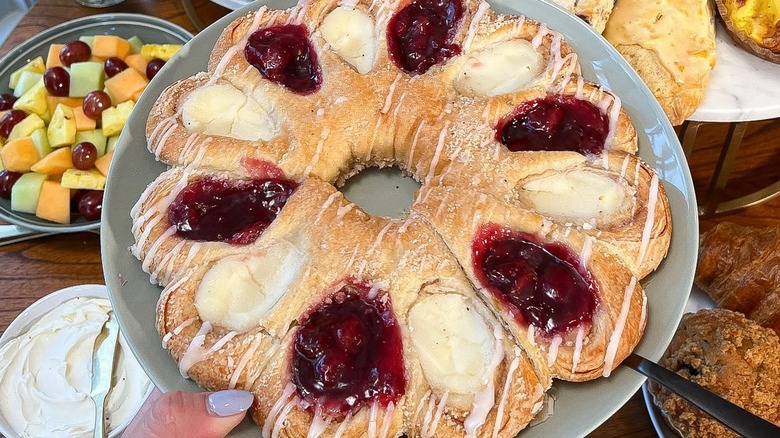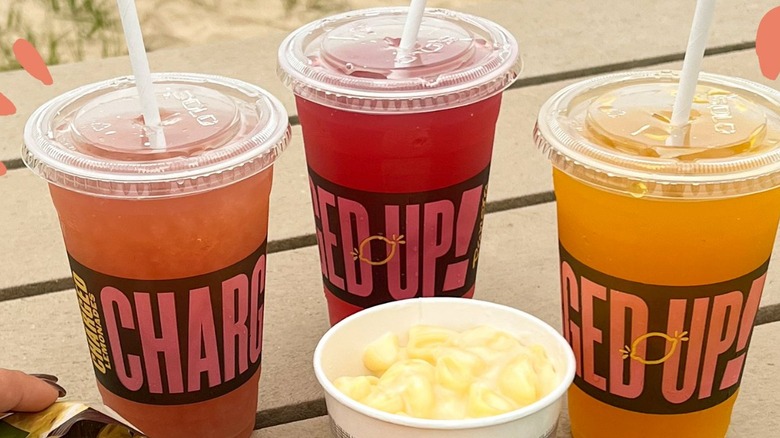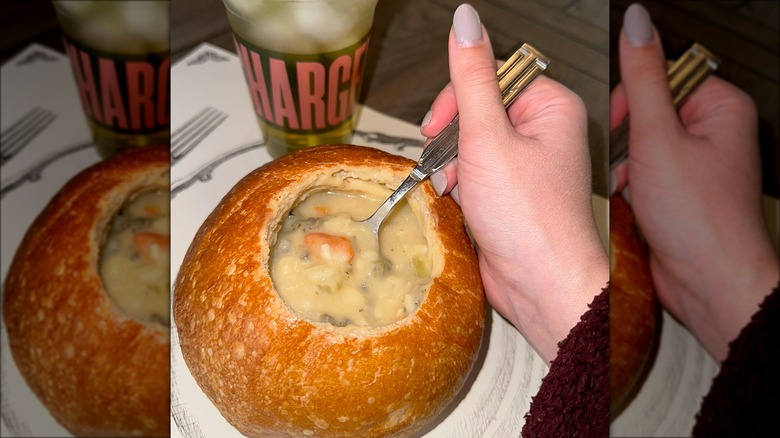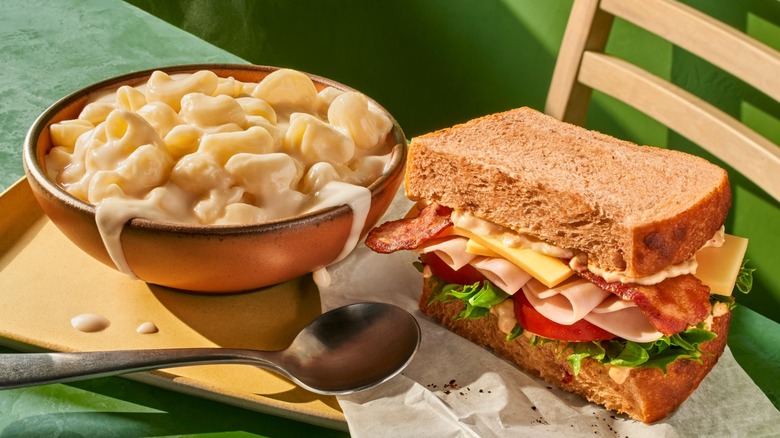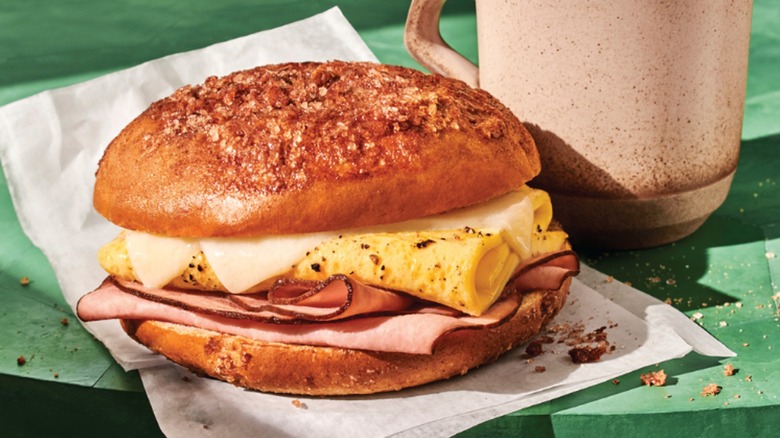Shady Things About Panera Bread's Menu
The more you look at Panera Bread's menu, the shadier it gets. If you've ever noticed that the kitchen area looks dark and abandoned, it's because very little food prep happens there. Nearly everything comes to the restaurant with minimal work necessary to get it ready for customers. There are no chefs in the back, and even the bakers have very little to do anymore. After learning how many Panera items come to the store premade, you might even decide to buy Panera Mac & Cheese or Panera soups at the grocery store and eat more cheaply at home instead.
Even though Panera has built its reputation on having a "clean menu," some of its menu items aren't as healthy and innocent as they seem or once were. Plus, some of its deals aren't deals at all. So a little scrutiny is necessary before choosing what to eat. Once you know the secrets of what's happening with Panera Bread's menu, you'll likely never look at it the same way again.
Panera bagels aren't boiled
One shady thing about the Panera Bread menu you'll notice if you're a bagel snob is that the bagel texture is different from traditional bagels. The textural difference is because boiling is not a part of the cooking process. The knowledge of how to make bagels arrived in New York with Eastern European Jewish immigrants in the late 1800s, and the process involved boiling. Boiling provides its distinctive chewy interior. During the quick 30- to 60-second boiling process, the outer starch makes a barrier that prevents the bagels from rising much more. The longer the boiling time, the harder the crust and the denser the bagels become.
However, Panera went a different route with its bagels, opting to steam them with a steam-injection oven rather than boil them. Steaming is an easier option in Panera's kitchen. The resulting bagels rise more and have an airy bread-like structure rather than a tight one. So they aren't as chewy, which can be a disappointment for anyone looking for New York-style bagels.
The ingredients may not be as clean as you think
In 2015, Panera started making a big push to clean up its menu, ultimately changing 122 of its 450 ingredients. The revisions left the chain with a "No No List" of artificial ingredients it vows not to use. A few former no-no ingredients disappeared from the list in 2024, including maltodextrin, phosphates, and sorbic acid. Plus, there are plenty of people who are skeptical about just how "clean" Panera's menu items are.
The No No List from Panera defines "clean" foods as having no "artificial preservatives, sweeteners, flavors, and colors." A lawsuit against the company in 2020 alleged that it was misrepresenting itself by still using multiple artificial ingredients. Some of the offending ingredients the lawsuit listed included the preservatives tocopherol (Vitamin E) and ascorbic acid (Vitamin C), which it alleged were artificial. Ultimately, the case was dismissed since it was filed in the wrong court system.
When GMO Free USA tested 44 chain restaurant foods for glyphosate in 2019, Panera had the highest quantity (per PR Newswire). Glyphosate is an herbicide farmers use on their crops to kill weeds, so it mainly affects plant-based menu items. While the FDA regulates its usage and researchers don't agree whether it's carcinogenic, the amount found in the food at Panera was at levels some think could potentially lead to health problems.
Panera might use clean ingredients, but that doesn't make all its menu items healthy
Knowing that Panera prides itself on using "clean ingredients" can easily fool you into thinking everything on the menu is healthy. A deeper look reveals problems — especially in terms of nutrition.
When looking at Panera's nutritional information, it's clear that "clean" doesn't necessarily mean "healthy." Its Mac & Cheese bread bowl has the most calories (1,150) and the most carbs (164 grams). A large bowl of Mac & Cheese has 64 grams of fat and 35 grams of saturated fat. When it comes to sodium, the Chicken Cordon Bleu Melt on a baguette is its worst offender, clocking in at 3,510 milligrams of sodium. It and other Panera menu items exceed the daily sodium recommendation of 2,300 milligrams. Interestingly enough, the pastries aren't as sugary as the drinks, with a 30-ounce Tropical Punch coming in at 112 grams of sugar.
You might think twice before adding a sourdough bread bowl to soup or Mac & Cheese. Adding a bread bowl increases the calorie count by 670. Plus it adds 40 grams of fat, 4.5 grams of saturated fat, 1,160 milligrams of sodium, 130 grams of carbs, and 2 grams of sugar.
Panera's Mac & Cheese is heated from frozen
Another shady thing about the Panera Bread menu is that its macaroni isn't made on-site. Our prevailing image of restaurants includes cooks busy making items from scratch in the kitchen. However, a mac and cheese chef does not exist at Panera because this menu item arrives frozen.
A Panera employee released a revealing video on TikTok in 2019 showing an employee dropping a single-serve frozen packet of pre-made macaroni into hot water for at least 20 minutes to thaw it. After thawing, the employee cut open the vacuum-sealed plastic packet with scissors, emptied the macaroni into a bowl, and served it to the customer.
There are several reasons Panera makes its macaroni off site. Not only can it keep its proprietary recipe a secret, but it can control the quality so that all restaurants are serving macaroni that tastes the same. Also, being frozen allows the chain to make it without preservatives and keep it "clean."
Its soup arrives at the restaurant frozen, too
There aren't any chefs in the kitchen making Panera's soups from scratch for the same reason the mac & cheese comes premade. Boxes of pre-packaged soups all arrive at the restaurant frozen into giant bricks. Then an employee thaws and heats them in a hot water bath in a thermalizer before pouring them into serving pans.
An anonymous Redditor explaining the process said, "Sometimes we didn't get to fully thaw out the soup in time and put some cold ones out there." If you've had cold spots in your Panera soup, the mystery is solved.
Redditor u/LP99 makes a good point when they say, "This is pretty much the same at any quick-serve or fast casual restaurant, any brand, any state. I don't think a bunch of high schoolers are whipping up made from scratch food every day for $4 an entree." After all, Panera has no chefs and hires bakers, salad and sandwich makers, and someone to head up catering. A fridge tech who spends a lot of time doing repair work in Panera's kitchen said on Reddit, "It is the only restaurant I know of where so little cooking goes on that they don't need a vent hood." Fittingly, they likened the cooking at Panera to "heating up MREs."
You may be getting yesterday's soup today
To add to your soup disappointment, the soup you're eating may not even be today's soup. While Panera has a Day-End Dough-Nation program to donate its baked goods to charities after closing time, it tends to hold onto its leftover soup.
Leftover soup is kept overnight in some locations that might shock you. A former Panera from 2017 and 2018 said on Reddit, "[W]e would tie off the leftover soup at close and put the bags in a sink full of ice and use the soup the next day." More recent employees confirmed this storage and cooling method, saying the ice would stay frozen all night. However, employees at other locations say they store leftover soup in the walk-in, so it varies between restaurants.
If you're among the first people ordering soup on any given day, there's a chance you could be eating yesterday's sink-cooled soup. So if fresh soup matters to you — at least, Panera's version of it — you might want to eat a later lunch or wait until supper to satisfy your soup craving.
Some drink machines get cleaned less often than others
One thing that can get overlooked in any restaurant is cleaning drink dispensers, and Panera is no exception. Even with a strict cleaning policy, some drink dispensers are more likely to get overlooked than others.
Panera's cleaning routine involves cleaning the soda fountains daily and the tea dispensers and bubblers at least every other day. Deep cleaning usually happens multiple times a week. However, it's the lemonade and tea dispensers behind the counter that some employees say get overlooked, and mold sometimes builds up in some areas of the machine not touching liquid.
If you notice that the tea at your Panera is starting to taste funky, there's a way to tell when it was last cleaned. Simply look on the other side of the name tag for the drink and check to see when the most recent day dot was added to indicate the last time it was cleaned.
The bread dough comes pre-made
If you've been harboring illusions that Panera bakers make bread from scratch, you have the wrong image of what's happening in Panera's kitchen. A third party makes the dough and ships it to the restaurant frozen. However, it's still baked fresh on-site every day.
Panera isn't the only chain restaurant famous for bread that arrives as frozen dough. For example, Subway bread dough also arrives frozen. So a chain restaurant making fresh bread from frozen dough is not as uncommon as you might think.
Currently, Panera bakers proof and bake the dough at night or the day before to have it ready for customers for the next day. However, as a part of a new initiative, employees say there are rumblings from general managers that the bread may one day arrive at the store par-baked. At that point, they might as well just bake the whole loaf off-site.
Few bakery items are assembled on-site
If you haven't figured it out by now, there aren't a whole lot of things made fresh in the kitchens at Panera. Panera bakers do have a few tasks to do, albeit not as much now as in the past.
Like the bread dough, the dough for all the pastries and baked goods comes pre-made. In the past, a few items required some assembly, but others arrived par-baked and just needed heating up to serve. However, in 2024, Bakery of the Future changes at Panera have led to bakers having even less to do. A Panera baker trainer told Nation's Restaurant News that "Our croissants, pecan braids, and cinnamon rolls are just a few items that have been completely redone to remove any prep before coming out of the oven, and minimal finishing after." Items that once needed proofing don't anymore.
The new changes condensed the baking hours down from eight to 12 hours to only two to four hours. As you can imagine, full-time bakers have been quitting in response to a new 16-hour work week. With these changes, it won't be long before the chain won't feel the need to hire anyone with baking experience to do its baking since most skilled work is done off-site.
Panera's bakery items are often older than you think
If you're expecting to get baked goods that have only just been made hours before, Panera is likely to disappoint you. At Panera, arriving when the location opens at 6:00 a.m. doesn't mean you're getting baked goods that were removed from the oven just before you arrived. Instead, they're likely to be at least 10 hours old or older.
As Panera has dumbed down the bakery process and shunk the bakers' working hours, it has also eliminated the overnight baking shift in some locations. Starting in 2022, the bakers who once worked overnight in some restaurants moved to the last shift before closing. So even if you're the first customer in the door in the morning in those locations, you're getting yesterday's baked goods. If you walk in the door just before closing and the bakers haven't replenished any inventory throughout the day, you could be getting an item that's a full day old.
Some locations replenish stock with newly baked items throughout the day. However, others only restock at the beginning of the day. If you're looking for the freshest possible items, your best bet is still to be there when the doors open in the morning.
The Charged Lemonades may have more caffeine than you assumed
Far too many people have been shocked by the caffeine level of the Charged Lemonades at Panera. For some, the mistake has been deadly. TikTokker @sarahebaus explained that she would often drink four or five free refills while working from Panera because they make her "feel like The Hulk." Once she researched the caffeine content, she said they "100% should be illegal." A regular 20-ounce one has 156 milligrams of caffeine, while a large 30-ounce one has 234 milligrams. A large Charged Lemonade is the equivalent of 2 ⅓ cups of coffee (19 ounces), almost seven cans of Coca-Cola (83 ounces), or nearly four shots of espresso. So you can see how someone could drink too much without realizing it.
The drink hits hard for people who have medical reasons to avoid stimulants and caffeine. People who usually avoid energy drinks and highly caffeinated drinks often don't realize they're getting such high levels of caffeine and guarana extract stimulants. A Florida man with mild intellectual challenges and high blood pressure died in 2023 after drinking three Charged Lemonades. A young college student with a medical condition that limited her caffeine intake also died in 2023 from drinking the drink, since Panera advertised it as only having as much caffeine as dark roast coffee. In 2024, even a healthy athlete ended up suing Panera after drinking two Charged Lemonades and ending up in the ER with heart palpitations and atrial fibrillation.
In May 2024, Panera said it would be removing the beverage from its menu.
You get less soup if you order a bread bowl
Ordering soup in a bread bowl is a little shady because of the sizing terminology at Panera. If you're ordering soup in a container rather than a bread bowl, it comes in two sizes: a cup or a bowl. The cup size contains a cup (eight ounces) of soup, and the bowl size contains 1½ cups (12 ounces) of soup. However, if you order a bread bowl, you don't get a "bowl" serving of soup.
Contrary to its name, a bread bowl comes with only a 1-cup serving of soup instead of a bowl serving of soup. So you're getting only a cup instead of 1½ cups of soup inside a bread bowl. Sorry to burst your bubble on that one.
If you were hoping for a bowl-sized serving of soup with your bread bowl, you can always use the hack of ordering the bread bowl and soup separately. But you should expect to pay a little more. For example, if you order a Broccoli Cheddar Soup bread bowl, it will cost only $9.19. However, if you order a bowl of soup at $8.89 and a bread bowl separately at $2.79, you'll end up spending $11.78, but get the amount of soup you want.
Value Duets are better deals than the You Pick Two menu
How you order menu items at Panera matters. Sometimes you can get the same thing for completely different prices, which is the case for Value Duets and the You Pick Two menu. Value Duets are always a better deal.
All the Value Duets are a single low price, while the prices of You Pick Two vary wildly depending on what you get. The You Pick Two menu allows you to pick two items from the menu, ranging from small or ½ sizes to large or full sizes. Since each item has a different price, ordering the two cheapest items would cost $9.78, while ordering the two most expensive ones would be $24.18. Meanwhile, the Value Duets menu features nine pre-paired soup and sandwich or soup and salad options, and the cost is always $7.99.
No matter which Value Duet you order, it's always going to be cheaper than ordering the same items off the You Pick Two menu. For example, ordering a Half Deli Ham Sandwich and a cup of Homestyle Chicken Noodle Soup from the Value Duets menu is only $7.99. However, they're $10.58 through the You Pick Two menu. There are a couple of advantages to ordering from the You Pick Two menu, though. There's more variety and you can get a free baguette, apple, chips, or fruit cup as a side (normally $0.99 to $3.99 extra).
It's loosening ingredient policies related to animal welfare
In light of its past animal welfare policies, some menu item changes Panera is making feel especially shady. In Panera Bread's statement of beliefs, it says at the time of writing, "We have long believed in humane treatment of animals. That's why we transitioned to cage-free eggs ... and use chicken raised without antibiotics." However, its standards have been relaxed from what they once were.
If you've been in a Panera since March 27, 2024, you will notice some signage and artwork missing that relates to vegetarian-fed, grass-fed, or pasture-raised animals. Also gone are any mentions of animal welfare as well as mention of some specific antibiotic-free or hormone-free animals. Its chickens are still antibiotic-free, but its pork and turkey products are not. And while its eggs still come from free-roaming chickens, its pork now comes from confined pigs.
The changes have come as a result of wanting to continue offering products that are more expensive or aren't always available from the supply chain when sourced ethically. The bottom line, however, is that these changes and proposed ones (like transitioning back to using confined chickens) will save the company $29 million.
